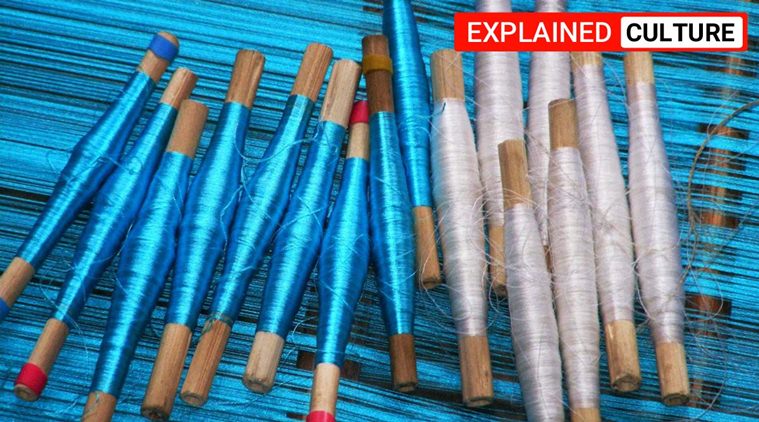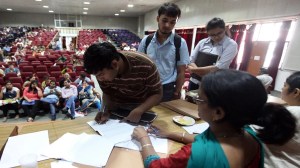- India
- International
Explained: Why we can’t easily wipe out China from India’s silk weaving industry
From Benares to Bengaluru, silk weavers rely on Chinese silk threads to get a better finish for their saris
 Nearly 80 per cent of the silk threads that weavers use across the country come from China. File/PTI Photo
Nearly 80 per cent of the silk threads that weavers use across the country come from China. File/PTI Photo
At a time when Chinese goods are frowned upon and slogans of ‘down with China’ fill media air, there’s one industry that will simply come to its knees without its primary raw material from China – India’s silk weaving industry.
“Without Chinese silk threads, not only will the entire industry come to a halt, but the heritage we have of woven silks, be it in Benares or elsewhere in the country will be lost,” says Varanasi-based master weaver Maqbool Hussain.
Nearly 80 per cent of the silk threads that weavers use across the country come from China. Of the rest, 10 per cent comes from Karnataka, and the rest from Bihar and Assam. In India, there are primarily four types of silk thread sources – domestic, which include mulberry and eri, and wild that includes tussar and muga. “There have been alternatives from Vietnam and Korea, but their scales of production don’t match our demand,” says Hussain.
Benarasi saris have been showpieces on the world’s stage, be it at London’s Great Exhibition of 1851, where the lavish use of zari and silk testified to the craft and skill of its weavers, or when the Vishwakarma exhibitions of the 1980s featured a collection of these saris.
“Known for their exquisite workmanship, the Benares saris long ago were made with tissue, silk, and fine pure zari, from silver threads coated in gold. If you melted a sari, you were left with a lump of metal that could fetch you a good sum in the days gone by. It was not unusual, therefore, for traders to go door to door and barter saris for bartans. The Surat zari of present times does not match that level of purity,” says Jaya Jaitly, President-Founder, Dastkari Haat Samiti.

With the dependence on Chinese silk threads, the Benarasi silk sari has taken a different shine and no longer holds the heaviness that came with pure zari. Secunderabad-based master weaver Gajam Govardhana, known for his ikkat dyeing tradition, testifies that silk weaving across the country today, from Salem and Erode to West Bengal, Rajasthan and Varanasi all depend on China for its threads.
The difference in quality between Chinese threads and threads from Karnataka is in the finish and thickness. Reeling is how the raw silk filaments are drawn out from the cocoon. And the machines in India do not give the smoothness or the shine that Chinese threads have. This leads to thicker threads which can be used on hand looms, but not on the warp in powerloom because of the speed with which the yarn is woven — and the chances of the breaking are greater.
“Our sericulture predates even China’s and our threads from Karnataka have better depth and strength than Chinese silk threads. However, our handicap is in the reeling and finishing,” says Hussain.
📣 Express Explained is now on Telegram. Click here to join our channel (@ieexplained) and stay updated with the latest
However, many skilled handloom weavers continue to use silk threads from Karnataka in their weft while weaving saris, though all powerloom weavers opt for Chinese threads for an even product. Given that many weavers in Benares have shifted to the powerloom, it’s not unusual for container loads of Chinese silk threads to arrive at local markets.
“The cost of Chinese silk threads is almost the same as that from Karnataka, which is anywhere between Rs 3,500 to Rs 5,000 per kg. However, with locally-made threads there is 25 per cent wastage after washing the threads,” says Govardhana.
Silk threads are always washed to get rid of the cocoon coating, while Chinese threads do not require any washing. A Benarasi sari requires approximately 800 g silk threads for its weave, while an Ikkat sari needs a kilogramme.
Govardhana faults the decrease in production in silk threads from Karnataka to the lack of support cocoon farmers receive.
Also in Explained | Chinese apps banned: A look at the most popular ones, their business and reach in India
“Farmers who produce vegetables and fruits for big companies are given more wholesome support by the state, because of which cocoon farmers are left high and dry,” he says. Jaitly believes that while Chinese silk threads are widely used, our own homegrown eri, tussar and khadi silk can be promoted and the cocoons made more accessible to weavers across the country.
For alternatives, the government should create an infrastructure too, says Hussain. Govardhana believes subsidies alone mean nothing. There can be a way for weavers to become self-reliant. “The state can identify weavers who are good and skilled. Build them a house and give them about 3 acre land, where they can grow their own raw materials, be it cotton, silk or they can do farming. So that they can alternate between seasons and farm and weave accordingly,” he says.
More Explained
EXPRESS OPINION
Apr 24: Latest News
- 01
- 02
- 03
- 04
- 05








































